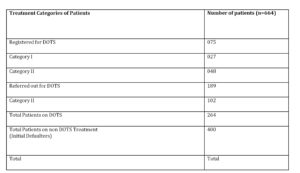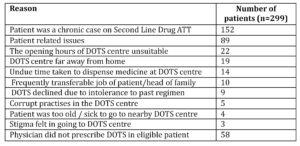Introduction
Revised National Tuberculosis Control Programme (RNTCP) uses Directly Observed Therapy — Short Course (DOTS) approach for treatment .2 Defaults occurring during treatment under DOTS are a well known entity. 3-6 Patients may also default prior to treatment initiation. “Initial default” is defined when a sputum smear positive patient has been recorded in the RNTCP Lab Register with at least 1 positive smear result and has not been registered under DOTS at the same centre or referred out for treatment at another centre. King George’s Medical University (erstwhile King George Medical College) situated at Lucknow is one of the main tertiary care centres for patients of tuberculosis in the state of Uttar Pradesh, and adjoining areas of the state of Madhya Pradesh and Bihar. To the best of our knowledge, there has been no study that analyses the extent and reasons of Initial Default at a medical college.
The main body of the paper
Materials and Methods
The study was conducted from 1 July 2008 to 30 June 2009. This was an observational study on a cohort of sputum smear positive patients aged more than 12 years. Patients with cough for more than 3 weeks were sent to the Designated Microscopy Centre cum DOTS centre and identified with a Lab Number. Till 31March 2009, 3 sputum samples were taken; a spot sample on the first day, a morning sample on the following day and another spot sample. After 1 April 2009, in compliance with changed RNTCP guidelines only 2 sputum samples were taken; a spot sample on the first day and early morning sample on the following day. Ziehl Neelsen staining of sputum smears was done. Grading of the smears was done as per RNTCP protocol and report of each patient was entered against their Lab Number.
Sputum smear positive patients referred out for DOTS at other centres were entered in the Referral Register and those treated at this centre were entered in the TB Register. Our study group comprised of patients with at least 1sputum smear positive report entered in the Lab register but absent from Referral register and TB Register. The patients were interviewed when they turned up in the OPD with their smear reports. Patient characteristics and ATT history was recorded. New cases were offered Cat I ATT under DOTS. Patients who had taken Cat I ATT were offered Cat II ATT for treatment under DOTS. Patients who refused Cat I and Cat II under DOTS were interviewed regarding reason for refusal of treatment under program and were started on daily ATT outside the program. Patients who had failed Cat II ATT and were sputum smear positive were prescribed Second Line Drug ATT. Data were collected using a structured and pretested questionnaire.
Result
Of the 2950 patients who underwent sputum smear examination, 664(22.5%) were sputum smear positive (SSP). Rest were sputum smear negative .Out of 664 SSP patients, 400 (60.2%) were initial defaulters. Rest 264 patients were registered/referred for DOTS. Feedback of the registered and referred patients was collected and it was found that all had completed treatment. Out of 400 initial defaulters, 101 (25.2%) couldn’t be studied. Among these, 25 (24.7%) didn’t return for smear results, 57(56.45%) collected their smear results but didn’t turn up in the OPD for treatment initiation, 16 (15.8%) collected their smear results and refused to participate in the study and 3 (2.9%) died before treatment initiation.
Out of 299 initial defaulters studied 152 (50.8%) were sputum smear positive after completing Category II DOTS. They were labelled chronic cases that were treated with unsupervised regimen of Second Line Drugs (SLDs). Among the rest initial defaulters who were eligible for DOTS, 89 (29.7%) had patient related issues with DOTS centre whereas physicians did not prescribe DOTS in 58 (19.3%) patients.Various reasons were cited by 89 (29.7%) patients for refusing DOTS treatment like unsuitable opening hours (22, 6.4%), distance of centres from home (19, 6.3%), overcrowding and long queues (14, 4.6%), jobs that led to frequent change in residence (10, 3.3%), intolerance to DOTS in the past (9, 3%) , certain corrupt practices at centres (5,1.6 %), old age or advanced disease preventing visits (4,1.3%), stigma ,and lack of trust in DOTS (3,1% each) .
Discussion
Initial default rates from past studies varied from 5% in Andhra Pradesh 7, 8 to 8% in Ho Chi Ming city Vietnam 9, 14-15% in Malawi 10 and 15%-26% in Cape Town, South Africa 11.An initial default rate of 60.2% in our study is quite high compared to other studies. High proportion of chronic cases in our study is possibly due to “referral bias”. Past studies on initial default were from the Primary or Secondary level health care centres. Ours study is from Medical College ,which is a centre for tertiary level healthcare in the three-tier hierarchical referral system of public sector healthcare in India12. The catchment area of King George Medical College covers a span of 300-400 kilometres 13. New cases and retreatment cases are dealt at the Primary and Secondary level healthcare centres by RNTCP DOTS, while the lack of specialist facilities leads to the referral of chronic cases to Tertiary level healthcare centres. The chronic cases diagnosed at our centre had failed a retreatment regimen of Cat II ATT under DOTS and were symptomatic with sputum smear positivity. They needed to be treated to prevent further morbidity to the patients and to prevent disease transmission in the community. We prescribed second line ATT drugs (SLD), since there were no DOTS Plus program in the state for treatment of chronic cases under programmatic settings. This group of patients may default due to the high cost of second line drugs and their associated toxicity. Covering these patients under the ambit of a program will ensure that treatment related issues are resolved and treatment completion is ensured.
89 (29.7%) initial defaulters refused DOTS due to patient related issues like improper timings (unsuitable opening hours that coincided with occupation), improper location (too far away), inadequate services (long dispensing time, corruption and lack of facilities for those incapable of attending centres) and wrong perceptions (stigma in attending centres, lack of trust in regimen efficacy and tolerance). RNTCP needs to assess itself and improve perceptions regarding its treatment strategy and service quality. Changes have to be made to RNTCP DOTS to make it acceptable to patients and to bring flexibility in its service.
58 (19.3%) initial defaulters were prescribed daily regimen of four drugs ATT (RHEZ) and five drugs ATT (SRHEZ) by faculty members of this teaching institute cum hospital. This shows an unfulfilled need for sensitizing and training medical college faculty about the merits of DOTS.
We analysed 299 (74.7%) of 400 initial defaulters for patient characteristics and cause of initial default. In the study by Gopi et al, only 33 (28%) of initial defaulters were talked to 8. In the study by Buu et al, only 166 (47.56%) out of 349 initial defaulters were analysed whereas the study on initial defaulters by Squire et al could access 5 patients (21.73%) and 14 caregivers among 23 initial defaulters in Malawi10, 11 .Compared to previous studies on initial default, we had access to a larger sample size of initial defaulters.
An analysis from Ghana showed cure rates are significantly lower and default rates are higher among initial defaulters14. Since initial defaulters’ outcomes are not included in TB treatment statistics, the actual number of treatment default from unsupervised regimens may be much higher than indicated by program statistics 15. In conclusion, aggressive tracing out the treatment outcome of initial defaulters should be implemented. DOTS plus needs to be implemented without delay at all Medical Colleges. Physicians and patients should be sensitised and made aware about the merits of Revised National Tuberculosis Control Program to further reduce initial default rates.
Table 1: Distribution of patients under DOTS

Table 2: Table 2 Reasons for not accessing initial defaulters for interview

Table 3: Reasons of Initial Default


Figure 1: Distribution of patients
Acknowledgment
None
References
1. Wares DF, Chauhan LS. (2003),’ Health policy, systems and services research and the Revised National Tuberculosis Control Programme,’ J Indian Med Assoc, 101, 177-9.
Google Scholar
2. Arora VK, Chauhan LS, Solanki RN, Ahir GC, Sarin R, Puneet, and et al. (2007), ‘Panel discussion on RNTCP implementation–problems and solutions,’ Indian JTuberc,54,140-4.
3. Jha UM, Satyanarayana S, Dewan PK, Chadha S, Wares F, Sahu S, and et al.( 2006),’ Risk Factors for Treatment Default among Re-Treatment Tuberculosis Patients in India’, PLoS One, 5,1-7.
4. Santha T, Garg R, Frieden TR, Chandrasekaran V, Subramani R, Gopi PG ,and et al . (2000),’ Risk factors associated with default, failure and death among tuberculosis patients treated in a DOTS programme in Tiruvallur District, South India’, Int J Tuberc Lung Dis,6,780-8.
5. Vijay S, Balasangameswara, VH, Jagannatha PS, Saroja VN , Kumar P.( 2005), ‘Defaults among tuberculosis patients treated under DOTS in Bangalore city: search for solution’, Indian J Tuberc,50, 185-195.
6. Hurting A, Porter, J, & Ogden J. (1999), ‘Tuberculosis control and directly observed therapy from the public health/human rights perspective’, International Journal of Tuberculosis and Lung Disease, 3,553-560.
7. Sai Babu B, Satyanarayana AVV, Venkateshwaralu G,Ramakrishna U,Vikram P, Sahu S et al. (2008),’Initial default among diagnosed sputum smear-positive pulmonary tuberculosis patients in Andhra Pradesh, India,’Int J Tuberc Lung Dis, 12,1055—1058.
Google Scholar
8. Gopi PG, Chandrasekaran V, Subramani R, Narayanan PR.( 2005),’ Failure To Initiate Treatment For Tuberculosis Patients Diagnosed In A Community Survey and At Health Facilities under A Dots Programme in A District Of South India,’ Indian J Tuberc, 52,153-156.
Google Scholar
9. Buu TN, Lonnroth K, Quy HT.( 2003), Initial defaulting in the National Tuberculosis Programme in Ho Chi Minh City, Vietnam: a survey of extent,reasons and alternative actions taken following default’, Int J Tuberc Lung Dis,7,735-741.
Google Scholar
10. Squire SB, Belaye AK, Kashoti A, Salaniponi FML, Mundy CJF, Theobald S, and et al. (2005),’Lost’ smear-positive pulmonary tuberculosis cases: where are they ad why did we lose them? ,’ Int J Tuberc Lung Dis, 9, 25—31.
Google Scholar
11. Botha E, Den Boon S, Verver S, et al. (2008),’ Initial default from tuberculosis treatment: how often does it happen and what are the reasons?,’ Int J Tuberc Lung Dis,12, 820-823.
Google Scholar
12. Nath B, Kumari R, Nidha T. (2008),’Utilization of the Health Care Delivery System in a District Of North India’, East African Journal of Public Health,5,147- 153.
13. Kumar R, Tripathi P, Singh S, Bannerji G.( 2006) ‘Clinical features in children hospitalized during the 2005 epidemic of Japanese encephalitis in Uttar Pradesh, India’, Clin Infect Dis, 43,123-31.
Publisher – Google Scholar
14. Afutu FK, Zachariah R, Hinderaker SG, Ntoah-Boadi H, Obeng EA,
Bonsu FA, and et al.( 2012),’ High initial default in patients with smear-positive pulmonary tuberculosis at a regional hospital in Accra, Ghana,’ Trans R Soc Trop Med Hyg,106,511-3.
15. Balasubramanian VN, Oommen K, Samuel R. (2000),’DOT or not? Direct observation of anti-tuberculosis treatment and patient outcomes, Kerala State, India’, Int J Tuberc Lung Dis, 4,409-13.
Google Scholar






